5 min read
The Art and Science of Crafting Powerful HubSpot Campaigns (+ Examples)
 George B. Thomas
Jul 28, 2023 10:52:42 AM
George B. Thomas
Jul 28, 2023 10:52:42 AM
Rather listen to this post?
If you’ve spent any amount of time in the marketing world, you’re likely no stranger to the word “campaigns.”
Email campaigns.
Newsletter campaigns.
ABM campaigns.
Ad campaigns.
Direct mail campaigns.
I could go on.
There are so many ways we can think about the word “campaign,” right? For today, though, we’re going to set aside those definitions as we explore exactly what HubSpot campaigns are.
What are HubSpot campaigns?
The HubSpot campaigns tool allows you to track the performance of all of the different pieces of a coordinated inbound effort.
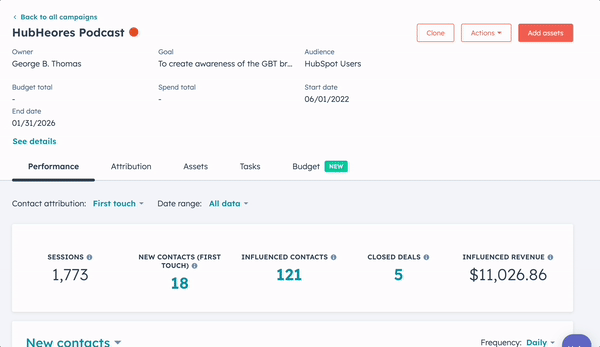
When I say “different pieces,” I’m talking about all of the different things you can build out in HubSpot:
- Landing pages
- Blog articles
- Calls-to-action
- Specific emails
- Individual social media posts
- CMS website pages
Now, how they relate to each other is entirely up to you and what you want to be tracking. In the example above, we love tracking all of the coordinated performance data of everything associated with the HubHeroes podcast.
🔎 Related: HubSpot social media strategy 101 (HubHeroes podcast)
Maybe you’re looking to track performance across all assets for a product launch, a particular series of content, or whatever else you might think of!
The real magic here is that you can demonstrate how effective all of your activities are across a single inbound campaign. Every single email, every single blog article … heck, again, even every single LinkedIn post:
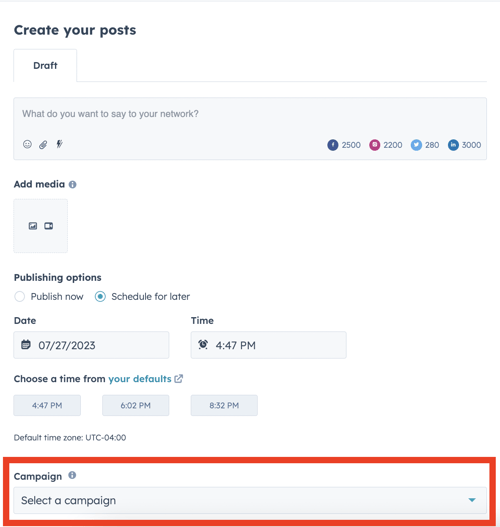
With HubSpot campaigns, you can show how everything works together to create a symphony of inbound success.
Trust me, this is the stuff of dreams when it comes to reporting ROI to business leadership. It’s also a great way to get a real-time snapshot of how well your campaigns are performing — and if they aren’t performing the way you’d hope, you’ll be able to see where you should be making adjustments.
Timelines, budgets, and goals in HubSpot campaigns
One of the coolest features of the HubSpot campaigns tool is that you can have campaigns set with no start or end date.
For example, if you have a long-term content series (like we do with HubHeroes) that will run in perpetuity. On the other hand, you can also have campaigns that run for a specific period of time with defined start and end dates.
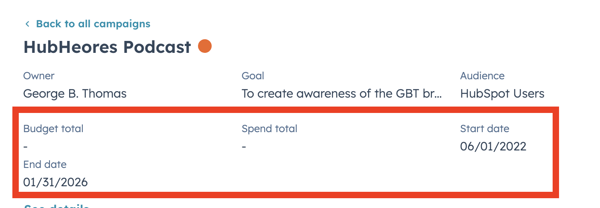
Additionally, let’s say you have a budget associated with a campaign. Now you can add that in there, too, so you can keep track of your spend vs. revenue return in a single spot.
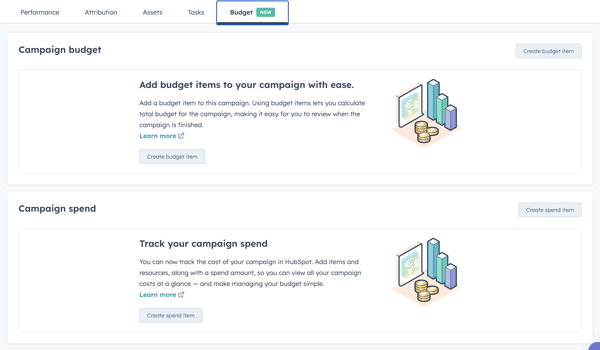
Now, for those of you who've been around the block with your guy, George for a bit, you're likely not going to be surprised by what I'm about to say next. There's one other little bit of information above that's essential for you to fill out for every campaign you create.
Can you guess what it is?
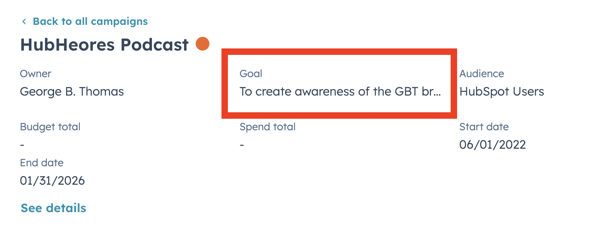
That's right, folks!
The same thing I said about goal-setting with HubSpot workflows applies to HubSpot campaigns, as well. You need to set a goal, even if it's broad in scope. You have to have a reason for a particular campaign for existing in HubSpot, so you and your teammates can stay aligned on the "why" behind the work you're doing, and the purpose of everything you're building and tracking.
🔎 Related: How to set big goals you'll actually keep (HubHeroes podcast)
A good rule of thumb for goal-setting with HubSpot campaigns? Specificity wins the day, folks!
What can you measure with HubSpot campaigns?
OK, maybe a better question is what can't you measure, performance-wise, in HubSpot campaigns? Whatever way you ask it, you've got a lot of data at your fingertips once you get your HubSpot campaigns up and running ...

Whether you're measuring by first touch or last touch (for a conversion), you can see how many sessions there were, new contacts created, how many contacts were influenced, how many deals were closed, and influenced revenue!
Then there's attribution reporting, which is ... well, just take a look:
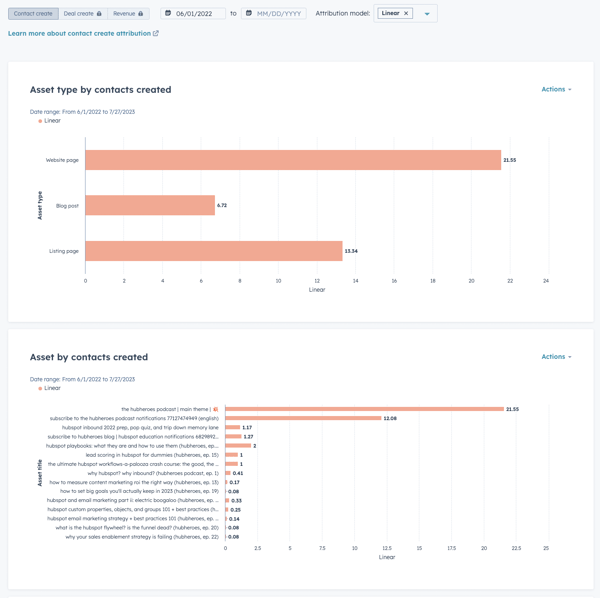
Why is attribution reporting important? Well, let's talk about what we can look at here from this data. What is on fire? Let's pour gasoline on it. What's not doing great? Is there anything that we could help do that? If we have enterprise instead of pro, I could literally do deal creation and revenue attribution as well.
Tasks and comments in HubSpot campaigns
One of the coolest parts of the HubSpot campaigns tool is that you can start conversations with comments within a particular campaign:
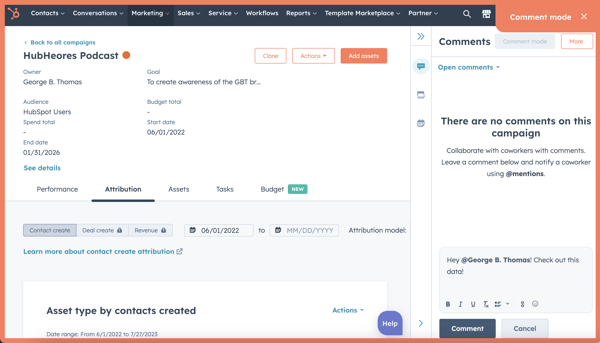
I can literally come in here and leave a comment about a certain thing on a campaign's dashboard to start a conversation internally with my team in a way that's completely visible to everyone. You can also add tasks from this view:
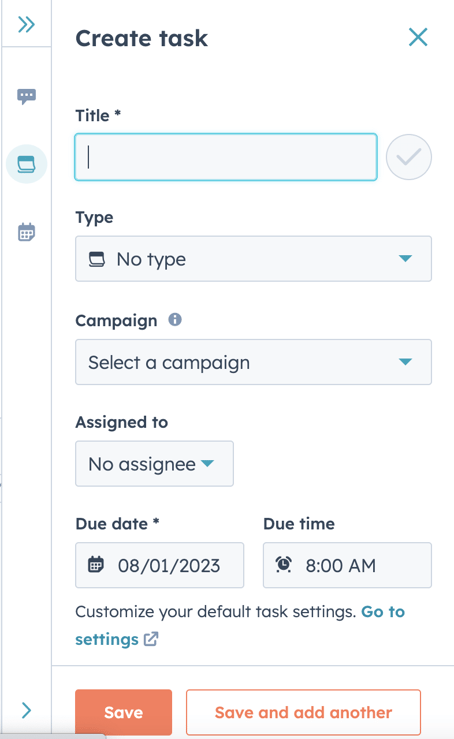
When it comes to tasks, you can put anything in here that will make your campaign better. Maybe that's writing three blog articles, maybe that's scheduling a set number of promotional posts on LinkedIn or Facebook, and so on.
🔎 Related: The last SEO content strategy guide you'll ever need
Now, pay attention to how I phrased that — create tasks that will "make your campaign better." This isn't a launch checklist to get a campaign off the ground. The best practice I always encourage here is about improvement on a campaign that's already running. Of course, you can run your HubSpot campaigns however you'd like, including with the tasks tool! Entirely up to you, this is just the way I've seen work best for us and our clients.
When do you need to create a HubSpot campaign?
This is probably one of the most common questions I get from our HubSpot training clients — "When do we know it's time to build a campaign around a set of assets in HubSpot?"
Personally, I only start thinking about creating a HubSpot campaign if there are three types of related assets that I know need to be combined and tracked together, from a performance perspective. If I create a one-off blog on a topic, that's not a campaign. If I create two or three hyper-specific blogs meant to promote and drive action toward the same hyper-specific CTA, that might be a campaign.
Because, when you think about it, a CTA isn't just one asset. It's also the landing page, and then the form that lives on that landing page, and so on.
🔎 Related: The blessings, tests, and surprises of 1 year as an agency owner
This restriction on attributing a single asset to only one HubSpot campaign is an important consideration to keep in mind. While it may seem limiting at first, it actually encourages you to think more strategically, creating focused campaigns that align with specific goals.
How does this help you? You'll see more clarity and accuracy in your reporting, allowing you to analyze the success of each campaign individually. So, while you cannot have one blog post tracked across multiple campaigns, this limitation ultimately helps you streamline your marketing efforts and gain valuable insights into the effectiveness of your campaigns.
Remember the human touch in your HubSpot campaigns
HubSpot campaigns are not just about boosting your marketing efforts, but also about making a meaningful impact on the lives of your customers. While it's easy to get caught up in the technical aspects and data-driven approach of campaign management, it's crucial to remember the ultimate goal: solving real problems for real people.
🔎 Related: You need to write (and market) like a human (+ examples)
Yes, this world is fast-paced, and you're focused now (more than ever) on remaining competitive in the market. But your customers are constantly being bombarded with marketing messages and offers. So, how do you stand out?
You create HubSpot campaigns rooted in empathy and understanding.
Instead of creating campaigns based on imagined problems or generic solutions, take the time to truly understand your target audience and their pain points. This human-centered approach not only builds trust but also fosters long-term loyalty. When you help your customers feel truly understood and supported, they are more likely to engage with your campaigns, share their experiences with others, and become advocates for your brand.
So, as you embark on your HubSpot campaigns, keep in mind that behind every click, every email, and every conversion, there is a real person seeking a solution. Take the time to listen, empathize, and craft campaigns that truly make a difference in their lives. By doing so, you'll not only achieve better results but also create a positive impact on the world.


